| Her Children |
|
| |
| Maria Theresa Charlotte |
| |
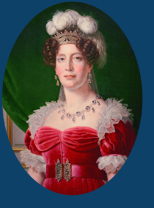 Marie Therese Charlotte was the first daughter of Marie Antoinette and Louis XVI and was born on December 19, 1778 in front of an enormous courtier's crowd. The new born was referred to as "Madame Royale", meaning the Princess Royal or eldest daughter of the King. Born at Versailles, she was raised under the guidance of her mother, her paternal aunt Madame Elisabeth, and a succession of governesses. Marie Therese Charlotte was the first daughter of Marie Antoinette and Louis XVI and was born on December 19, 1778 in front of an enormous courtier's crowd. The new born was referred to as "Madame Royale", meaning the Princess Royal or eldest daughter of the King. Born at Versailles, she was raised under the guidance of her mother, her paternal aunt Madame Elisabeth, and a succession of governesses.
When violence erupted in 1789, she was not yet eleven. During the next six years, she witnessed terrifying events, which haunted her through out her life. The lives of all four children born to Louis XVI and Marie Antoinette ended tragically; only Marie Therese Charlotte reached adulthood.
In July of 1789, the outbreak of the French Revolution and the raiding of the Bastille threatened to upset the lifestyle of the Royal family. Along with the other members of her family, she was forcibly moved to Paris and was imprisoned in the Tuileries Palace. During June of 1791, she accompanied her family in their ill-fated attempt to escape from France through Varennes . After the King was recognized, they were dragged back to Paris in humiliation. She was also present when an angry mob stormed the Tuileries, effectively ending the monarchy. The next morning, over a 1,000 bodies lay strewn within the Palace and grounds.
 Her mother used to call her the brave “Mousseline” when they were shut in the Temple Prison together. Sometime during late September of 1793, they were separated. Marie Antoinette was transferred to the Conciergerie Prison. She and her brother remained in the Temple Prison in separate cells, never to see one another again. Like a maddening torture, she was incarcerated in the Temple for three years and was divided from her parents, and her aunt, one by one as they were sent to the guillotine. Her mother used to call her the brave “Mousseline” when they were shut in the Temple Prison together. Sometime during late September of 1793, they were separated. Marie Antoinette was transferred to the Conciergerie Prison. She and her brother remained in the Temple Prison in separate cells, never to see one another again. Like a maddening torture, she was incarcerated in the Temple for three years and was divided from her parents, and her aunt, one by one as they were sent to the guillotine.
In 1795, Louis Charles died within the Prison Temple walls and she was exchanged for a number of French revolutionaries held by Austria. She alone of her family survived the bloody Revolution. As a female ancestor, she could not inherit the crown on France. Unlike her brother Louis Charles, she was not a political threat to the Revolution.
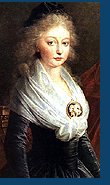 Soon after, she married her first cousin the Duke of Angouleme, the son of Charles X. In May of 1799, she joined her Bourbon relatives at Mittau in Lithuania. Madame Royale eventually returned to France under the reign of Louis XVIII on April 24, 1814. It had been said that the restoration would not be complete until the arrival of Madame Royale. She was the only woman who could be described as a “woman of the Tuileries”. “It is she who attracts all eyes and represents the legend of the Temple Prison, the one who may be called the living poetry of the Restoration”. Soon after, she married her first cousin the Duke of Angouleme, the son of Charles X. In May of 1799, she joined her Bourbon relatives at Mittau in Lithuania. Madame Royale eventually returned to France under the reign of Louis XVIII on April 24, 1814. It had been said that the restoration would not be complete until the arrival of Madame Royale. She was the only woman who could be described as a “woman of the Tuileries”. “It is she who attracts all eyes and represents the legend of the Temple Prison, the one who may be called the living poetry of the Restoration”.
As soon as the Duchess touched the French soil, people turned more especially toward the young Neapolitan Princess. But from 1814 to 1816, the most important position at court belonged to the daughter of Louis XVI.
Within a year of the monarchy's first restoration, Napoleon threatened to return from Elba. She tried to organize resistance to Napoleon's return. In Napoleon's own words he is said to have described her as "the only man in [her] family."
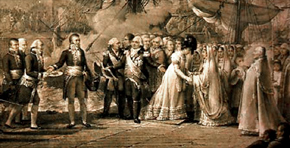
With the second restoration of the monarchy in 1815, the people were far from being in the tender mood of the preceding year. The French people were plunged into a patriotic sort of depression, being tossed to and fro from imperialism back to monarchy. Nowhere could good reason for exultation be found.
It was the very coincidence between the defeat of the French and the return of the Bourbons that so fatally handicapped a government that would, under so many other circumstances have been respected, and reparative. It is for this reason that the Duchess of Angoulême wished so much that Napoleon should be repulsed by the French themselves instead of succumbing under the blows of foreign armies.
During the reigns of her uncles Louis XVIII and the accession of her father-in-law, Charles X, to the throne of France in 1824 , she was the Dauphine and held the highest female rank at court. In 1830, she was Queen of France for twenty minutes between the time her father-in-law signed the instrument of abdication and the time her husband, reluctantly, signed the same document, twenty minutes later. However, once her husband abdicated she was forced once again into exile.
She took refuge near Edinburgh, and then in Prague. In 1844, her husband the Duke of Angouleme died. During her lifetime, she physically unable to have children. On October 19, 1851, she died at the age of seventy-one at the Castle of Frosdorf in Gorz, the capital of former Austria. She was buried in the Bourbon family crypt in the Franciscan monastery of Castagnavizza in Gorizia, Italy.
Included with her biography is her proclamation to French people in regard to Napoleon's attempt to return from Elba and re-claim France. |
| |
Proclaimation of the Duchess d' Angouleme |
| |
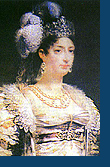 "If the voice of your legitimate King has not yet reached you, I now make you hear it. It is in his name; in virtue of the powers he has confided to me, that I address you. Faithful Frenchmen join the daughter of your Kings. She does not bring you war; she speaks to you only of peace and union. She laments the frightful calamities brought upon you by treason and perjury; she cannot look without terror to those of which war may still render you the victims. Frenchmen, in the name of the country, of your families, of all that you hold most dear and sacred upon earth, rise all, join yourselves to me to secure the triumph of the paternal views of the best of Kings." "If the voice of your legitimate King has not yet reached you, I now make you hear it. It is in his name; in virtue of the powers he has confided to me, that I address you. Faithful Frenchmen join the daughter of your Kings. She does not bring you war; she speaks to you only of peace and union. She laments the frightful calamities brought upon you by treason and perjury; she cannot look without terror to those of which war may still render you the victims. Frenchmen, in the name of the country, of your families, of all that you hold most dear and sacred upon earth, rise all, join yourselves to me to secure the triumph of the paternal views of the best of Kings."
"Frenchmen, time is precious, victorious armies advance; let a truly national movement, and the expression of our fidelity to our King, at once put an end to a war, not undertaken from ambition and the love of conquest, but from necessity of saving France and Europe. Frenchmen, raise the standard of fidelity, and you shall see me in the midst of you."
Maria Theresa Charlotte
Her Royal Highness the Duchess D'Angouleme
London, June 26, 1815 |
|
| |










|
|
|
|
| |
| Louis Joseph Xavier Francois |
| |
 Dauphin Louis Joseph Xavier Francois, the Duke of Normandy, and was the first son of Louis XVI and Marie Antoinette. He was born on October 22, 1781 in Versailles. Dauphin Louis Joseph Xavier Francois, the Duke of Normandy, and was the first son of Louis XVI and Marie Antoinette. He was born on October 22, 1781 in Versailles.
When the Dauphin was very young, his mother had his clothing made to match the dresses that she had in her own wardrobe. Traditionally, young children, no matter their sex, wore dresses. Louis XVI felt that wearing that type of clothing would traumatize his son. As a result, Louis XVI was determined to dress his sons in more boyish fashions at an early age. Louis Joseph was reportedly outfitted in boyish-styled clothes, which was an innovation for French royal male children called "skeleton suits". The skeleton suits notably have long pants and (in Britain) knee breeches.
The Dauphin, Louis Joseph, had several nurses. The most famous is Madame Poitrine who may have inadvertently transmitted tuberculosis to him. The education of a future leader, of course, is of great importance in any monarchy.
His governesses reared him until the age of six, and his education was finally entrusted to the Duc d'Harcourt. Both Louis XVI and Marie Antoinette took a great interest in the education of their son. His father ordered a globe of the world from the famed geographer Nantelle. The globe was transformable and displayed the land and submerged geographical features.
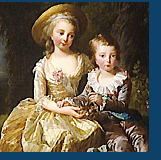 He was described as intelligent, affectionate, and a sickly child. The Dauphin and his sister Marie Theresa are reportedly very close to their parents. This was not always the case for royal children. He was described as intelligent, affectionate, and a sickly child. The Dauphin and his sister Marie Theresa are reportedly very close to their parents. This was not always the case for royal children.
At the age of three, serious medical problems began to be reported in April of 1784 when the Dauphin experienced strong fevers. Minor illnesses followed but were not severe, even so his health slowly deteriorated. Inoculation was an early form of vaccines, which helped people resist diseases were ineffective. Doctors noted that in April of 1786 the Dauphin's backbone began to curve. The first symptoms of tuberculosis appeared in October of 1786. From 1786 to 1787, the doctors attempted to correct the curvature of the boy's backbone with an iron corset.
By the spring of 1788, his health had so deteriorated that his body was becoming visibly deformed. His back was hunched and his legs could no longer support his own weight. The Dauphin in January of 1788 was consumed with constant fevers. The disease progresses quickly. Dr. Petit diagnoses a "vertebral decay" better known as Gangrene, which did develop in his spine. The young Dauphin died at the Chateau de Meudon on June 4, 1789. He was seven years and seven months old at his death. There are far fewer images of Louis-Joseph. The images that do exist were generally made before the revolution and involved actual settings. |
| |
|
| |
 
 |
|
| Louis Charles, Louis XVII |
| |
 Louis Charles, Duc du Berry and the titular King of France, known in popular legend as the “lost Dauphin”, was born on March 27, 1785 in Versailles. He was the second son of Louis XVI and Marie Antoinette, and became Dauphin at the death of his elder brother. In 1792, the revolutionists imprisoned him with the royal family in the Temple Prison. After the execution of Louis XVI on January 21, 1793, the Comte de Provence (later King Louis XVIII) and other French nobles that had been exiled proclaimed the Dauphin to be King as Louis XVII. He never had the opportunity to rule. Louis Charles, Duc du Berry and the titular King of France, known in popular legend as the “lost Dauphin”, was born on March 27, 1785 in Versailles. He was the second son of Louis XVI and Marie Antoinette, and became Dauphin at the death of his elder brother. In 1792, the revolutionists imprisoned him with the royal family in the Temple Prison. After the execution of Louis XVI on January 21, 1793, the Comte de Provence (later King Louis XVIII) and other French nobles that had been exiled proclaimed the Dauphin to be King as Louis XVII. He never had the opportunity to rule.
On July 3, 1793, he was taken from his mother and put under the care of a cobbler, Antoine Simon, still within the grounds of the Temple Prison. The harsh conditions of his confinement quickly undermined his health. Suffering from cruel mistreatment and the early stages of tuberculoses, he died on June 8, 1795. He was ten years and two months of age at his death.
Five people were allowed to examine the body and later testified that he was the Dauphin of France. However, these people never saw the Dauphin while he was alive, which further added to the mystery of the "lost Dauphin". The authorities never consulted the Dauphin's sister, Maria Theresa Charlotte, who also was being held in the Temple Prison. He was buried in the St. Marguerite Cemetery, France.
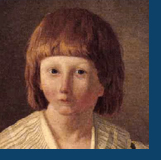 His death was a severe blow to the constitutional monarchists who had once again become a powerful political force. The secrecy surrounding his last months gave rise to many rumors that he had been murdered or had escaped. His death was a severe blow to the constitutional monarchists who had once again become a powerful political force. The secrecy surrounding his last months gave rise to many rumors that he had been murdered or had escaped.
Evidence has long indicated that the boy died in Temple Prison in 1795. Historians, for the most part, had disregarded the "lost Dauphin" theory altogether. On April 19, 2000, geneticists announced that they had compared DNA from the dead boy's preserved heart with DNA from members of the royal family and proved conclusively that the child who died in prison was indeed the Dauphin.
His remains were moved permanently and laid to rest at the side of his parents, Louis XVI and Marie Antoinette, in the St. Denis Basilica.
There are literally hundreds of images available of Louis Charles. Many are fanciful made without ever seeing the boy. These images were made because Louis Charles became an icon for the royalist forces fighting the Revolution. |
|
| |
 


|
|
| Sophie Helene Beatrix |
| |
 Sophie Helene Beatrix was born on July 9, 1786 and was named for one of her father’s aunts that died a couple of years previously. Sophie Helene Beatrix was born on July 9, 1786 and was named for one of her father’s aunts that died a couple of years previously.
She was the fourth child of Louis XVI and Marie Antoinette. Sophie died at the age of eleven months old on June 19, 1787. |
|
| |
  |
| |
| |
|

 Marie Therese Charlotte was the first daughter of Marie Antoinette and Louis XVI and was born on December 19, 1778 in front of an enormous courtier's crowd. The new born was referred to as "Madame Royale", meaning the Princess Royal or eldest daughter of the King. Born at Versailles, she was raised under the guidance of her mother, her paternal aunt Madame Elisabeth, and a succession of governesses.
Marie Therese Charlotte was the first daughter of Marie Antoinette and Louis XVI and was born on December 19, 1778 in front of an enormous courtier's crowd. The new born was referred to as "Madame Royale", meaning the Princess Royal or eldest daughter of the King. Born at Versailles, she was raised under the guidance of her mother, her paternal aunt Madame Elisabeth, and a succession of governesses.  Her mother used to call her the brave “Mousseline” when they were shut in the Temple Prison together. Sometime during late September of 1793, they were separated. Marie Antoinette was transferred to the Conciergerie Prison. She and her brother remained in the Temple Prison in separate cells, never to see one another again. Like a maddening torture, she was incarcerated in the Temple for three years and was divided from her parents, and her aunt, one by one as they were sent to the guillotine.
Her mother used to call her the brave “Mousseline” when they were shut in the Temple Prison together. Sometime during late September of 1793, they were separated. Marie Antoinette was transferred to the Conciergerie Prison. She and her brother remained in the Temple Prison in separate cells, never to see one another again. Like a maddening torture, she was incarcerated in the Temple for three years and was divided from her parents, and her aunt, one by one as they were sent to the guillotine.  Soon after, she married her first cousin the Duke of Angouleme, the son of Charles X. In May of 1799, she joined her Bourbon relatives at Mittau in Lithuania. Madame Royale eventually returned to France under the reign of Louis XVIII on April 24, 1814. It had been said that the restoration would not be complete until the arrival of Madame Royale. She was the only woman who could be described as a “woman of the Tuileries”. “It is she who attracts all eyes and represents the legend of the Temple Prison, the one who may be called the living poetry of the Restoration”.
Soon after, she married her first cousin the Duke of Angouleme, the son of Charles X. In May of 1799, she joined her Bourbon relatives at Mittau in Lithuania. Madame Royale eventually returned to France under the reign of Louis XVIII on April 24, 1814. It had been said that the restoration would not be complete until the arrival of Madame Royale. She was the only woman who could be described as a “woman of the Tuileries”. “It is she who attracts all eyes and represents the legend of the Temple Prison, the one who may be called the living poetry of the Restoration”. 
 "If the voice of your legitimate King has not yet reached you, I now make you hear it. It is in his name; in virtue of the powers he has confided to me, that I address you. Faithful Frenchmen join the daughter of your Kings. She does not bring you war; she speaks to you only of peace and union. She laments the frightful calamities brought upon you by treason and perjury; she cannot look without terror to those of which war may still render you the victims. Frenchmen, in the name of the country, of your families, of all that you hold most dear and sacred upon earth, rise all, join yourselves to me to secure the triumph of the paternal views of the best of Kings."
"If the voice of your legitimate King has not yet reached you, I now make you hear it. It is in his name; in virtue of the powers he has confided to me, that I address you. Faithful Frenchmen join the daughter of your Kings. She does not bring you war; she speaks to you only of peace and union. She laments the frightful calamities brought upon you by treason and perjury; she cannot look without terror to those of which war may still render you the victims. Frenchmen, in the name of the country, of your families, of all that you hold most dear and sacred upon earth, rise all, join yourselves to me to secure the triumph of the paternal views of the best of Kings."  Dauphin Louis Joseph Xavier Francois, the Duke of Normandy, and was the first son of Louis XVI and Marie Antoinette. He was born on October 22, 1781 in Versailles.
Dauphin Louis Joseph Xavier Francois, the Duke of Normandy, and was the first son of Louis XVI and Marie Antoinette. He was born on October 22, 1781 in Versailles.  He was described as intelligent, affectionate, and a sickly child. The Dauphin and his sister Marie Theresa are reportedly very close to their parents. This was not always the case for royal children.
He was described as intelligent, affectionate, and a sickly child. The Dauphin and his sister Marie Theresa are reportedly very close to their parents. This was not always the case for royal children.  Louis Charles, Duc du Berry and the titular King of France, known in popular legend as the “lost Dauphin”, was born on March 27, 1785 in Versailles. He was the second son of Louis XVI and Marie Antoinette, and became Dauphin at the death of his elder brother. In 1792, the revolutionists imprisoned him with the royal family in the Temple Prison. After the execution of Louis XVI on January 21, 1793, the Comte de Provence (later King Louis XVIII) and other French nobles that had been exiled proclaimed the Dauphin to be King as Louis XVII. He never had the opportunity to rule.
Louis Charles, Duc du Berry and the titular King of France, known in popular legend as the “lost Dauphin”, was born on March 27, 1785 in Versailles. He was the second son of Louis XVI and Marie Antoinette, and became Dauphin at the death of his elder brother. In 1792, the revolutionists imprisoned him with the royal family in the Temple Prison. After the execution of Louis XVI on January 21, 1793, the Comte de Provence (later King Louis XVIII) and other French nobles that had been exiled proclaimed the Dauphin to be King as Louis XVII. He never had the opportunity to rule.  His death was a severe blow to the constitutional monarchists who had once again become a powerful political force. The secrecy surrounding his last months gave rise to many rumors that he had been murdered or had escaped.
His death was a severe blow to the constitutional monarchists who had once again become a powerful political force. The secrecy surrounding his last months gave rise to many rumors that he had been murdered or had escaped.  Sophie Helene Beatrix was born on July 9, 1786 and was named for one of her father’s aunts that died a couple of years previously.
Sophie Helene Beatrix was born on July 9, 1786 and was named for one of her father’s aunts that died a couple of years previously.